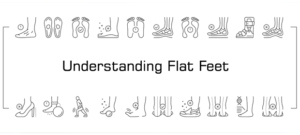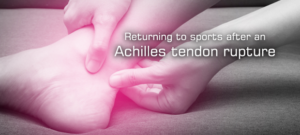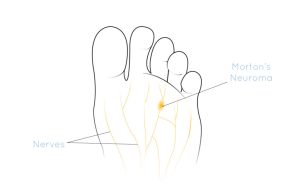Hammer, Claw, and Mallet Toes-Explore the Differences Hammer, claw, and mallet toes can all be regarded as toe deformities whereby toes are bent into odd positions. […]
Preventing Callus and Corn formation
Preventing Callus and Corn formation

Preventing Callus and Corn formation
Callus and corns are extremely common on our feet. A thin layer of flexible callus is a healthy protective barrier of the skin. Corns however do not have any benefit and can be immensely painful. Here is information and advice on these two common complaints.
Callus
Callus is thickened, hard skin developed from friction. Common areas to find these on the feet are:
- Lateral (outside) of the 5th toes
- Tips of the toes
- Medial (towards midline of the body) of the big toe joints
- Under the metatarsophalangeal joints (balls of the feet)
- Heels
The above areas of the foot tend to experience the most pressure and friction. Points 1 & 2 are signs that your footwear should be wider and longer. If your shoes are narrow, they will create friction on the sides of the 5th toes. If your toes butt up against the end of your shoe, you can develop callus on the apices of the toes.
Point 3 is mechanically induced, often seen in runners or people who may require orthotics (insoles) to improve foot function.
The plantar metatarsophalangeal joints (point 4) take a high amount of pressure and friction, as we use this area to ‘push off’ when walking or running. Sports that involve pivoting and change of direction such as netball, basketball and tennis tend to exacerbate this.
Heels (point 5) are involved when we make contact with the ground, and take the initial shock absorption. Heel contact generally moves from the lateral (outside) towards the medial (inside) during gait, and can develop callus around the edges.
A thin layer of flexible callus is usually healthy but you should file down or have a podiatrist shave thick and solid callus down for you. Consider orthotics to help reduce high friction areas, and wear good fitted shoes. A podiatrist can help you with this.
Corns
Corns are developed from pressure. High pressure areas of the foot can compact skin cells into one small location and develop into an inverted cone like shape. These become gradually larger until you feel pain. They can be removed painlessly by a podiatrist using a scalpel, but they will redevelop if high pressure to the area continues. Areas that are commonly affected include:
- Sides of 5th toes
- Between toes
- Top of toes (interphalangeal joints)
- Under the metatarsophalangeal joints
Points 1 and 2 indicate your shoes are too tight and are squeezing your toes together. Point 3 indicates your toes are being squashed at the end of the shoe, causing the toes to claw. The clawing pushes the interphalangeal joints (IPJs) upwards and they rub on the top of the shoe. This can cause both callus and corn formation.
The 4th point is very common and is naturally a high pressure area when walking. Tight calf muscles will increase forefoot pressure so stretching these muscles is important. A high arched foot tends to have high pressure at the heel and forefoot as less surface area contacts the ground (pressure = force/area). You may benefit from using an orthotic to increase surface area contact, with or without modification to offload a particular area.
Corn formation is usually a result of poor footwear. Try to alter your footwear or use a comfortable shoe for commuting, and wearing dress shoes for minimum periods. For recurring corns, see a podiatrist and you may benefit from a pair of orthotics (insoles).
CONTACT US
Please get in touch if you would like to discuss callus and corn treatment or prevention.
T. – 0207 412 8882
E. – admin@podogo.com
A. – 27 Harley Street, London, W1G 9QP
Written by Steven Thomas – Podiatrist, on behalf of Podogo
©Podogo Ltd. 2020
SCHEDULE A CONSULTATION
Recent Posts
Categories
Related Blogs
Thoughts and advice on foot health care from the Podogo team.
Ingrown Toenails and Footwear: Tips for Choosing the Right Shoes
Ingrown Toenails and Footwear: Tips for Choosing the Right Shoes An ingrown toenail can be a cause some discomfort and pain. They can become tiresome when […]
Top Reasons to Visit a Podiatry Clinic: Caring for Your Feet
Top Reasons to Visit a Podiatry Clinic: Caring for Your Feet One of the advantages of getting checked by a podiatrist is that they can examine […]
Performance Boosters: Maximising Potential with Sports Orthotics
Performance Boosters: Maximising Potential with Sports Orthotics Individuals who are active in sports aim to work towards maximising their potential and overall performance. Dexterity, endurance, and strength are […]
How to Choose the Right Verruca Treatment for You?
How to Choose the Right Verruca Treatment for You? A verruca, also referred to as plantar warts, can be a persistent problem. Theyappear as growths triggered by […]
What You Need to Know About Flat Feet Treatment & Effectiveness of Orthotics
What You Need to Know About Flat Feet Treatment & Effectiveness of Orthotics Flat feet, also referred to as fallen arches, is a condition where the arches […]
Transform Your Foot Health with Orthopaedic Insoles
Transform Your Foot Health with Orthopaedic Insoles Many people suffer from foot pain and discomfort, it is possible to alleviate some of these issues by using the appropriate support for […]
Shockwave Therapy and Heel Pain
Shockwave Therapy and Heel Pain ESWT (Extracorporeal Shockwave Therapy) is a non-invasive surgical procedure that involves sound waves. The sound waves are utilised to stimulate the […]
When Is Surgery Needed for Heel Pain?
When Is Surgery Needed for Heel Pain? Heel pain is a common issue that can cause pain whilst standing or walking. There are many cases where […]
When is Surgery needed for a Flat Foot Issue?
When is Surgery needed for a Flat Foot Issue? Flat foot surgery is intended to correct the present alignment of your feet, ease any pain you […]
Understanding Hammer Toe
Understanding Hammer Toe Hammer toe affects your second, fourth, and third toes which causes them to bend at the middle joint, making them appear like a […]
How Does Cryotherapy Treat Verrucae?
How Does Cryotherapy Treat Verrucae? Verrucae, referred to as plantar warts, are rough and small growths that usually appear on the soles of your feet. These […]
Understanding Flat Feet
Understanding Flat Feet Flat feet, also referred to as pes planus, indicate a condition where the arches of your feet have collapsed, this can become very […]
What is an ingrown toenail?
What is an ingrown toenail? An ingrown toenail develops when the sides of the toenail cut in to the skin. The body treats the nail as […]
Stepping with Comfort: A Guide to Common Foot Conditions
Stepping with Comfort: A Guide to Common Foot Conditions There are 26 bones in a human foot, with 33 joints and a minimum of 100 muscles, […]
Returning to Sports After an Achilles Tendon Rupture
Returning to Sports After an Achilles Tendon Rupture An ATR (Achilles tendon rupture) is a rather common injury among individuals who tend to be physically active. […]
The Latest Advancements in Lapidus Hallux Valgus Surgery
The Latest Advancements in Lapidus Hallux Valgus Surgery Correcting hallux valgus is one of the most common procedures undertaken by foot and ankle specialists. There have […]
What is a Podiatrist and their training
What is a Podiatrist and their training [betterdocs_search_form placeholder=”Search”] When it comes to taking care of our bodies, our feet often get overlooked. Enter the podiatrist, […]
Understanding Steroid Injections: A Podiatrist’s Guide
Understanding Steroid Injections: A Podiatrist’s Guide [betterdocs_search_form placeholder=”Search”] What are Steroid Injections? Steroid injections are commonly used in the field of podiatry to alleviate pain and […]
The Benefits of Shockwave Therapy for Podiatry Patients
The Benefits of Shockwave Therapy for Podiatry Patients [betterdocs_search_form placeholder=”Search”] What is Shockwave Therapy? Shockwave therapy is a non-invasive and highly effective treatment method for various […]
Treating Sports Injuries: Shockwave Therapy vs. Steroid Injections
Treating Sports Injuries: Shockwave Therapy vs. Steroid Injections [betterdocs_search_form placeholder=”Search”] Sports Injuries Sports injuries are a common occurrence among athletes, weekend footballers and beginner joggers. Sports […]
Ankle Sprain or Fracture
Ankle Sprains and Fractures [betterdocs_search_form placeholder=”Search”] Ankle sprains and fractures are common injuries that can effect both very active and sedentary people. At Podogo Foot Clinic, […]
Ingrown Toenail Remedies You Can Do at Home
Ingrown Toenail Remedies You Can Do at Home [betterdocs_search_form placeholder=”Search”] Ingrown nails whether on the fingers or toes develop when the side of the nail starts […]
Treatment for verrucae and warts
Treatment for verrucae and warts [betterdocs_search_form placeholder=”Search”] Verrucas and warts are very common and are contagious so you should be careful when walking barefoot. They are […]
What is biomechanical gait assessment?
What is biomechanical gait assessment? [betterdocs_search_form placeholder=”Search”] A gait analysis and biomechanical assessment are two different types of assessment, they are both ways of examining how […]
Heel pain and plantar fasciitis exercises
Heel pain and plantar fasciitis exercises [betterdocs_search_form placeholder=”Search”] There are many causes of heel pain but one of the biggest causes is plantar fasciitis which affects […]
Common Questions About Plantar Fasciitis
Common Questions About Plantar Fasciitis [betterdocs_search_form placeholder=”Search”] What is the main cause of plantar fasciitis? It is generally classed as an overuse injury that gradually worsens. […]
Common Questions About Verruca
Common Question about Verrucae [betterdocs_search_form placeholder=”Search”] Do verruca go away on their own? They can go away on their own but there is no guarantee of […]
Surgery for Ingrown Toenails
Ingrown Toenail Surgery | All You Need to Know About it What is an ingrown toenail? An ingrown toenail is when part of the toenail has broken or pierced the surrounding skin. What causes an ingrown toenail? They are often caused by malcutting, leaving a shard down the side of...
Metatarsalgia – Pain in the ball of the foot when walking
What causes pain in the ball of the foot when walking? There are a number of possible causes for this. The ‘balls’ of the feet are technically, the metatarsophalangeal joints (MTP joints). Pain in this area can mean that one of these joints, or the structures or surrounding structures of...
What is a Foot Corn?
What is a Foot Corn? Appearance A corn is a bump of hard skin on the foot. They typically appear as a raised hard, yellowish patch of skin that is often tender to touch and painful when walking or wearing shoes. A corn is not normally a serious health condition....
What is the pain in the ball of my foot?
What is the pain in the ball of my foot? It is quite common to feel pain and inflammation around the balls of the feet. Podiatrists refer to these symptoms as Metatarsalgia, although this is not a condition in itself. The balls of the feet are the slightly padded areas...
The Best Verruca Treatments
The Best Verruca Treatments What is a Verruca? A Verruca is a small lump of hard skin, also known as a plantar wart, that grows on the sole of the foot. Verrucae typically appear as a small black dot beneath the surface of the skin with hard skin growing on...
Treating Ingrown Toenails
Treating Ingrown Toenails What is an ingrown toenail Ingrown toenails occur when the nail starts to pierce the skin and soft flesh surrounding it. This is quite common and typically affects the big toes. Often this condition is caused by: Wearing tight shoes that push the toes together Cutting your...
Plantar Fasciitis
Plantar Fasciitis The plantar fascia is a structure under the foot that connects the heel to the metatarsophalangeal joints (MTPJs) or commonly called the ‘balls of the feet’. Plantar fasciitis refers to inflammation of the fascia that produces symptoms. The typical location of symptoms are where the fascia inserts into...
What Is a Morton’s Neuroma?
What Is a Morton’s Neuroma? A Morton’s Neuroma is a thickened, damaged or irritated nerve between your toes. This can cause pain, discomfort or restriction in footwear and may require specialist treatment. A Morton’s neuroma is found between the third and fourth webbing space of the foot but neuromas can...
Preventing Callus and Corn formation
Preventing Callus and Corn formation Callus and corns are extremely common on our feet. A thin layer of flexible callus is a healthy protective barrier of the skin. Corns however do not have any benefit and can be immensely painful. Here is information and advice on these two common complaints....
Verrucae
Verrucae are warts on the foot and are caused by a virus. When present under the foot they can be very painful to walk on, particularly if under high pressure areas. The virus itself does not cause pain, but the hard skin it develops does. Verrucae are contagious and spread...
Orthotics
Orthotics Orthotics are commonly known as insoles and are worn inside shoes. They ultimately change forces on your foot and can be used for a variety of reasons. Thin flat cushioned insoles available from a number of high street shops can improve general comfort. However, for people with foot complaints...
National Bunion Day
National Bunion Day A bunion is a deformity of the foot involving the big toe joint. This is often painful and can cause a number of secondary problems. The medical term for bunion is ‘hallux valgus’, and it affects around 23% of adults – women more than men. The big...
Easter walks
Easter Walks After a period of cold and dark winter weather, the temperature is rising. Trees are sprouting fresh green leaves, and flowers begin to bloom and add colour to the landscape. This is a pleasant invitation to explore outside. You may be planning a city break away or trip...
Valentines Day and wearing heels
Valentines Day and wearing heels As you may be planning to wear heels this Valentine’s Day, here is some advice to consider from a foot and ankle specialist. All feet and people are unique and will therefore be prone to different types of problems and symptoms. However, the main factors...
Preparing for the London Marathon
Preparing For The London Marathon Preparing for the London Marathon is different for each individual. For some, running the marathon will be the first time they run this distance. For others, it may be a frequent event alongside triathlons and ultramarathons. The closer you are to the later group, the...
New Year’s Resolutions
New Year’s Resolutions Most people make New Year’s resolutions, and the classic one is ‘to keep fit and get in shape’. Based on clinical experience, I see many patients in late January and February due injuries as a direct result of their resolutions. This is not a good start to...
Common Foot Issues & Foot Treatment
Common Foot Issues & Foot Treatment Athlete’s Foot: Athlete’s foot is one of the most common foot related issues that people may suffer from. The foot treatment for this particular issue is rather simple. You just keep his feet dry and clean at all times, as well as use a...
Planters Foot: An Inflammation of A Ligament In Your Foot
Planters Foot: An Inflammation of A Ligament In Your Foot In medical terminology planters foot is known as plantar fasciitis. It is basically an inflammation of a ligament in your foot named the plantar fascia.
What You Need to Know About Foot Injuries
What You Need to Know About Foot Injuries Each foot in your body has 26 bones, 33 joints, and at least 100 tendons, ligaments, and muscles. This is the reason why foot injuries are so common
Sore Feet: Pain & Discomfort in Your Feet
Sore Feet: Pain & Discomfort in Your Feet The term sore feet means what it says – pain and discomfort in your feet. There are several symptoms of sore feet that may be mentioned as below: Hammer toe Discolored skin Bunions Corns Calluses Heel pain Arch pain If you have...
How To Find The Right Foot Care Centre
How To Find The Right Foot Care Centre Though we generally associate foot pain or injuries with athletes, we should not fail to acknowledge the fact that they can be experienced by anyone. A well equipped foot care centre should ideally provide all the following treatment options: Bunion Treatment Heel...
How to Protect Your Ankle from Sports Related Injuries
How to Protect Your Ankle from Sports Related Injuries If you are into sports and fitness activities, then you will be well aware of the fact that ankle injuries are quite common and you may know how to avoid them.


















































